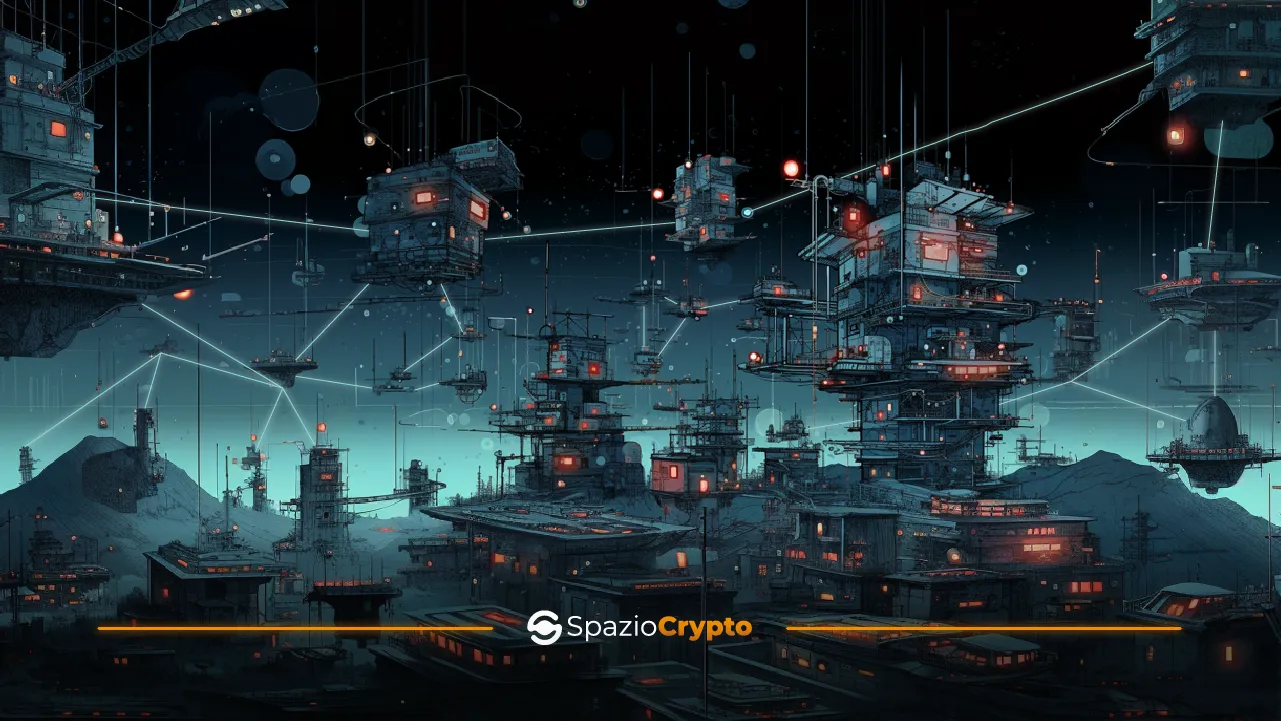In this recent period, a revolutionary concept is emerging: decentralised physical networks (DePINs). Based on blockchain and cryptocurrency principles, DePIN projects offer a number of advantages over traditional centralised infrastructures.
At the heart of this revolution is the concept of decentralisation. Centralised infrastructures, such as those run by large technology companies like Google or Microsoft, hold immense power over the flow of digital information and services. This concentration of power poses significant risks, including censorship, lack of transparency and vulnerability to cyber attacks. Decentralised physical networks (DePINs), on the other hand, distribute power and responsibility among a network of participants, eliminating the need for a central authority. This results in greater resistance to censorship, improved transparency and enhanced security. In addition, DePIN projects can exploit tokens-based incentive mechanisms to motivate participation and network governance, creating a more efficient and equitable system.
The potential benefits of DePIN are vast and far-reaching. Decentralisation can unlock the potential of innovation and enable new forms of collaboration and digital ownership. Transparency can reduce abuse of power and promote greater trust in digital systems. Economic efficiency and cost reduction can make access to digital technologies more equitable and affordable for all.
However, DePINs are not without their challenges. In this article in Spaziocrypto's Web3 Guide we will address in depth both the potential and challenges facing the DePIN sector.
How Do Decentralised Physical Infrastructures (DePINs) Work?
At the heart of the DePIN revolution lies an ingenious architecture that harnesses the power of blockchain and tokens to create decentralised digital infrastructures. To fully understand the potential of DePINs, it is crucial to understand the underlying mechanisms that power their operation.
Basic architecture of a DePIN infrastructure
Let's imagine a network of distributed nodes, each controlled by an individual or organisation. These nodes host physical resources, such as storage servers, computing power or network bandwidth. The blockchain acts as an immutable backbone, recording the ownership of these resources and the transactions that occur on the network.
The Role of Tokens
Tokens play a crucial role in motivating participation and governance of DePINs. Token holders can earn rewards for providing resources to the network, such as storing data or sharing bandwidth. These tokens can also be used to vote on decisions related to the operation of the network, ensuring a democratic and transparent system.
Consensus mechanisms
To ensure the consistency and reliability of the network, DePINs employ consensus mechanisms. These protocols define how nodes reach agreement on transactions and status updates. Some common consensus algorithms include Proof of Work (PoW), Proof of Stake (PoS) and algorithms based on Byzantine Fault Tolerance (BFT).
Technical and security challenges
DePIN projects, while promising, present technical and security challenges that require attention. Scalability is critical to support large numbers of users and transactions. Data security and resilience to cyber attacks are essential to protect sensitive information. In addition, managing complexity and ensuring an intuitive user interface are crucial for wide adoption.
Examples of DePIN projects
Numerous DePIN projects are emerging, exploring different applications and solutions. Filecoin, for instance, offers decentralised data storage solutions, exploiting users' unused storage space. Another example can be Golem, which distributes computing power in a decentralised manner, enabling the unused computing power of users' devices to be harnessed.
The diversity of use cases demonstrates the versatility and potential of DePINs to revolutionise various aspects of the digital infrastructure.
DePINs therefore represent a decentralised alternative to traditional centralised infrastructures. Understanding the architecture, mechanisms and challenges of DePINs is key to assessing their potential impact and role in shaping the future of the digital world.
The Benefits of DePIN Projects
Decentralised Physical Networks (DePINs) promise to transform the digital landscape by offering a number of advantages over traditional centralised infrastructures.
Decentralisation and censorship resistance
A key advantage of DePIN networks is their inherent resistance to censorship. In centralised infrastructures, control is concentrated in the hands of a central authority, which can potentially censor content or restrict access to information. DePINs, on the other hand, distribute power among a network of participants, making it extremely difficult for any single entity to impose censorship. This ensures freedom of expression and open access to information for all users.
Increased transparency and accountability
The decentralised nature of DePINs promotes increased transparency and accountability. All transactions and activities on the network are recorded on the blockchain, creating an immutable register accessible to all. This allows users to monitor the flow of data and resources, preventing potential abuse or fraud. Furthermore, the decentralised governance of DePINs ensures that all users have a say in decisions that affect the network, promoting a fairer and more democratic system.
Economic Efficiency and Cost Reduction
DePINs have the potential to improve economic efficiency and reduce infrastructure costs. By eliminating the need for centralised intermediaries, DePINs can reduce fees and transaction costs. In addition, the efficient use of distributed resources within the network can optimise the utilisation of resources such as storage, computing power and bandwidth, generating significant savings for users.
Positive social and political impact
The benefits of DePINs extend beyond technical improvements, as they can have a positive social and political impact. Decentralisation can promote digital inclusion and enable marginalised communities to access services and information that might otherwise be inaccessible. In addition, increased transparency and accountability can strengthen trust in institutions and foster greater civic participation.
Use Case Examples
- Decentralised Media and Social Networks: Some DePIN networks can enable the creation of censorship-resistant social media and information platforms where users have control over their own data and experience.
- Decentralised Finance (DeFi): DePIN projects can facilitate peer-to-peer financial transactions without the need for centralised intermediaries, promoting financial inclusion and reducing costs.
- Digital Identity: DePINs can provide users with greater control over their digital identity, enabling them to manage and share their information securely and transparently.
Decentralisation offers a path to a more censorship-resistant, transparent, efficient and democratic digital infrastructure. As DePIN technology matures and adoption grows, its potential to revolutionise society and the economy becomes increasingly evident.
DePIN Challenges and Opportunities
Decentralised physical networks (DePINs) offer immense potential to transform the digital infrastructure, but they are not without challenges. In this chapter, we will examine the key challenges that DePINs face, balancing them with the future opportunities that this revolutionary technology may present
Technical challenges
- Scalability:Managing large numbers of users and transactions on a decentralised network requires effective scalability solutions.
- Security: Protecting data and resources from cyber attacks is critical to DePIN's trust and adoption.
- Efficiency: Optimising resource utilisation and reducing transaction costs are crucial to DePIN's competitiveness.
Regulatory and legal challenges
- Cryptocurrency regulation: The lack of regulatory clarity on cryptocurrencies can hinder the adoption and use of DePIN networks.
- Data Protection and Privacy: Ensuring compliance with data protection and user privacy regulations is essential.
- Intellectual Property: Defining ownership and management of intellectual property rights within DePIN projects is a complex challenge.
Adoption Challenges
- Awareness and Education: Increasing awareness and understanding of DePINs among the public is critical for widespread adoption.
- Usability and User Interface: Creating intuitive and easy-to-use user interfaces is essential to attracting new users.
- Integration with existing systems:Integrating DePIN networks with existing infrastructure and systems is necessary for a smooth transition.
Future opportunities
- New applications and use cases: The development of new applications and use cases leveraging the unique capabilities of DePINs can lead to revolutionary innovations.
- Impact on economy and society: The integration of DePIN networks can promote digital inclusion, economic equity and participatory democracy.
- Technological Evolution:Advances in blockchain technology, artificial intelligence and cryptography can further advance DePIN's capabilities.
The challenges facing the DePIN sector are significant, but the opportunities it presents are even greater. With continued research and development, careful attention to regulatory issues and a commitment to widespread adoption, the DePIN network industry has the potential to create a more decentralised, democratic and efficient future. The journey has just begun. As the technology evolves and adoption grows, its impact on society and the economy will become increasingly evident.
DePIN: Towards a Decentralised Digital Future
Decentralised Physical Networks (DePINs) represent a revolutionary paradigm in infrastructure and data management, offering a decentralised alternative to traditional centralised infrastructures.
However, the path towards a decentralised digital future is fraught with challenges. Overcoming technical barriers, addressing regulatory issues and fostering widespread adoption will be crucial to the success of the DePIN industry. Despite the challenges, the opportunities are immense. The possibility of creating a more censorship-resistant, transparent, democratic and efficient digital infrastructure can have a profound impact on society and the economy.
If we can overcome these obstacles, at Spaziocrypto, we are convinced that the DePIN sector has the potential to create a fairer, more democratic and secure digital future for all. The choice is ours: embrace this revolutionary change and shape a better future for the digital world.








